GOES-R Series News | 2024
-
December 21, 2024: The Winter Solstice Through NOAA’s Newest Eyes in Space

NOAA’s newest satellite, GOES-19, provided a beautiful view of Earth during the winter solstice. Currently positioned over the Western Hemisphere at 89.5° west longitude, between NOAA’s GOES East and GOES West satellites, GOES-19 captured this celestial moment from space while undergoing post-launch testing. Launched on June 25, it is set to replace GOES-16 in the GOES East position this spring. The winter solstice marks a special moment as the shortest day and longest night of the year in the Northern Hemisphere. At precisely 4:21 a.m. EST, the Northern Hemisphere reached its maximum tilt away from the sun, positioning the sun directly over the Tropic of Capricorn, 23.5° south of the equator.
December
-
November 25, 2024: Earth from Orbit: 2024 Atlantic Hurricane Season Wraps UpTEST!!
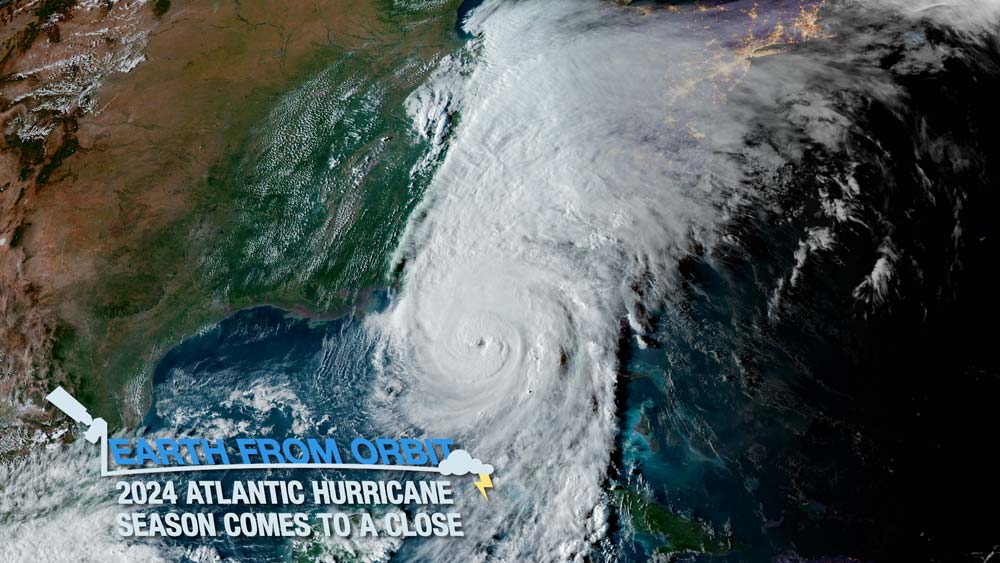
As the 2024 Atlantic hurricane season comes to a close on Nov. 30, NOAA looks back at its above-average activity, with a record-breaking ramp up following a peak-season lull. The Atlantic basin saw 18 named storms with 11 intensifying into hurricanes. Five of those were major hurricanes intensifying into Category 3 or higher. GOES-16 (GOES East) is constantly monitoring the Atlantic basin for the development of tropical storm systems. Once a storm forms, GOES-16 tracks its development, movement and intensity and measures lighting activity in near real-time.
-
November 12, 2024: GOES-19 Captures Extended Images of the Sun's Atmosphere:
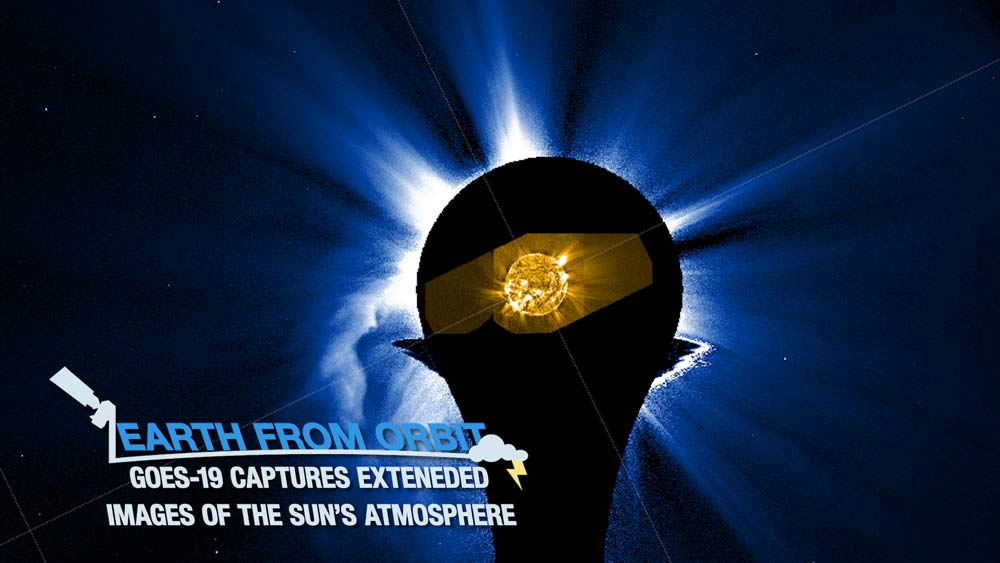
NOAA’s newest satellite, GOES-19, has been monitoring an increasingly active sun, as we enter solar maximum of Solar Cycle 25. The GOES-19 Solar Ultraviolet Imager (SUVI) and a brand-new Compact Coronagraph (CCOR-1) are now observing the sun and its influence on Earth. Recently, the GOES-19 SUVI operated in a special mode, called “extended coronal imaging (ECI).” Typically, SUVI capture’s the sun’s activity in six types of extreme ultraviolet light, each showing different temperatures on the sun. During ECI, SUVI captured images slightly off-center from the sun, using two of these light types (171 Å and 195 Å). By doing this, scientists can create three-panel mosaic images that reveal more of the sun’s outer atmosphere, known as the middle corona. This extended view helps connect the details in SUVI images with the new CCOR-1 images. As GOES-19 undergoes post-launch testing before becoming NOAA’s operational GOES East satellite in spring 2025, its data should be considered preliminary and non-operational. Once operational, the Space Weather Prediction Center (SWPC) will use data from both CCOR-1 and SUVI to issue early warnings and improve the accuracy of forecasts, protecting vital infrastructure from space weather threats.
November
-
October 29, 2024: NOAA Shares First Imagery from GOES-19 SUVI Instrument
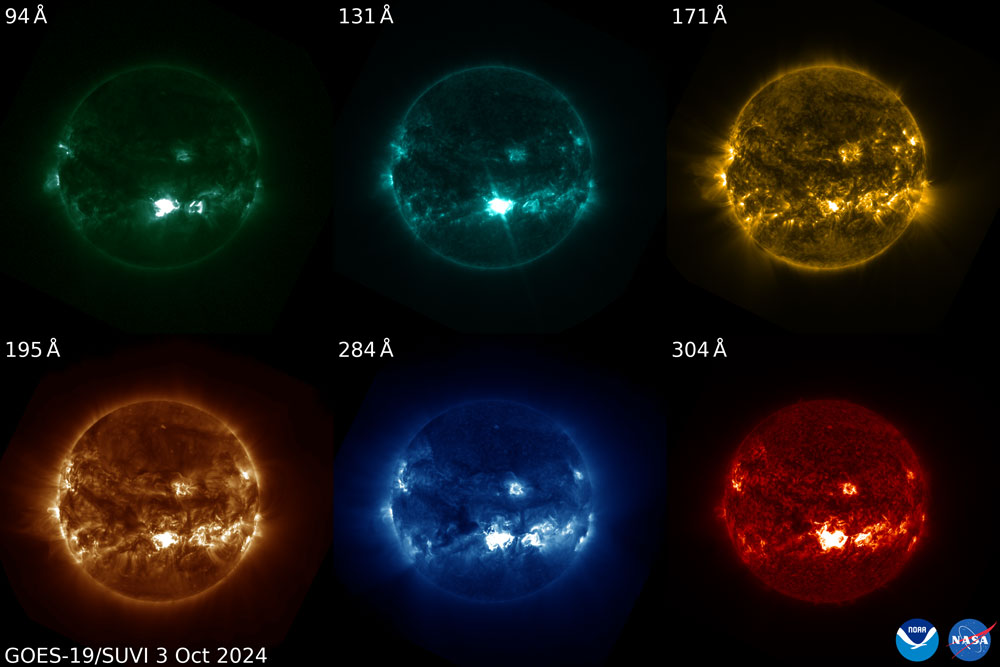
GOES-19 imagery of the Oct. 3, 2024, solar flare shown in six extreme ultraviolet channels. The clearest depiction of the flare is in the 131 Å channel (top center). On Oct. 29, 2024, NOAA shared the first imagery from the GOES-19 Solar Ultraviolet Imager (SUVI). The GOES-19 SUVI, which launched on June 25, 2024, began observing the sun on Sept. 24, 2024. On Oct. 3, 2024, the GOES-19 SUVI captured an X9 solar flare, the most powerful flare so far in the current solar cycle. The sun’s 11-year activity cycle has entered the solar maximum period, meaning phenomena such as solar flares and coronal mass ejections are occurring more frequently than during other parts of the solar cycle. SUVI monitors the sun in the extreme ultraviolet portion of the electromagnetic spectrum to watch for hazardous space weather that could affect Earth.
-
October 17, 2024: NOAA Releases Initial Imagery from the GOES-19 Lightning Mapper
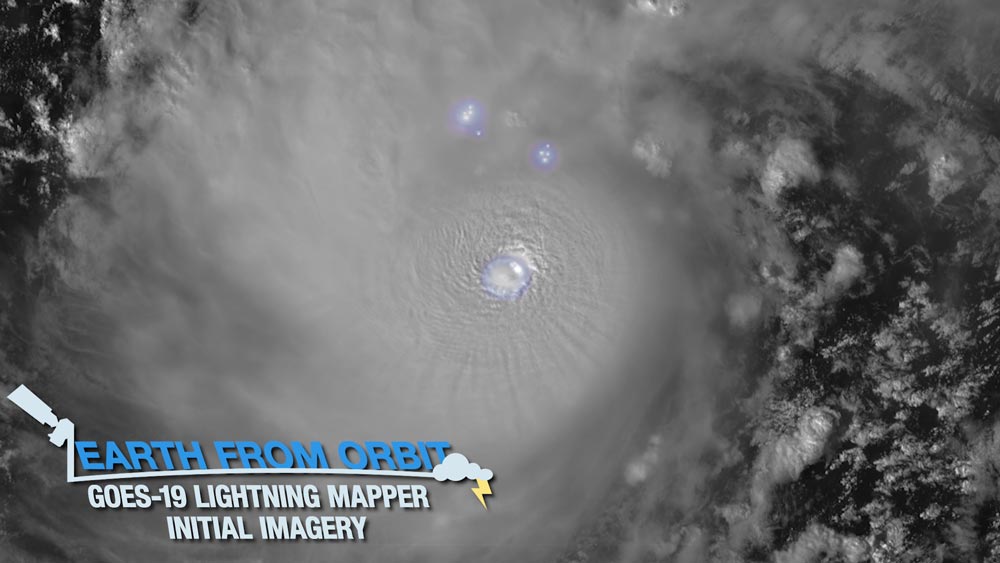
NOAA Releases Initial Imagery from the GOES-19 Lightning Mapper On Oct. 17, 2024, NOAA shared initial imagery from the GOES-19 lightning Mapper. The GOES-19 Geostationary Lightning Mapper (GLM) instrument, launched on June 25, 2024, is now continuously observing lightning over the Western Hemisphere. Recently, the GOES-19 GLM detected and monitored lightning activity in two extremely hazardous hurricanes – Helene and Milton. Lightning activity in the outer rainbands and eyewalls of these hurricanes was associated with rapid intensification. Frequent lightning outside the Hurricane Milton’s core was associated with intense rain bands that produced widespread flash flooding and tornadoes across Florida on Oct. 9, 2024. GOES-19 is currently undergoing post-launch testing, which includes validation and calibration of its instruments, systems and data to prepare it for operations. NOAA plans for GOES-19 to replace GOES-16 as GOES East in April 2025
-
October 3, 2024: GOES-R/GeoXO Newsletter, April – September 2024
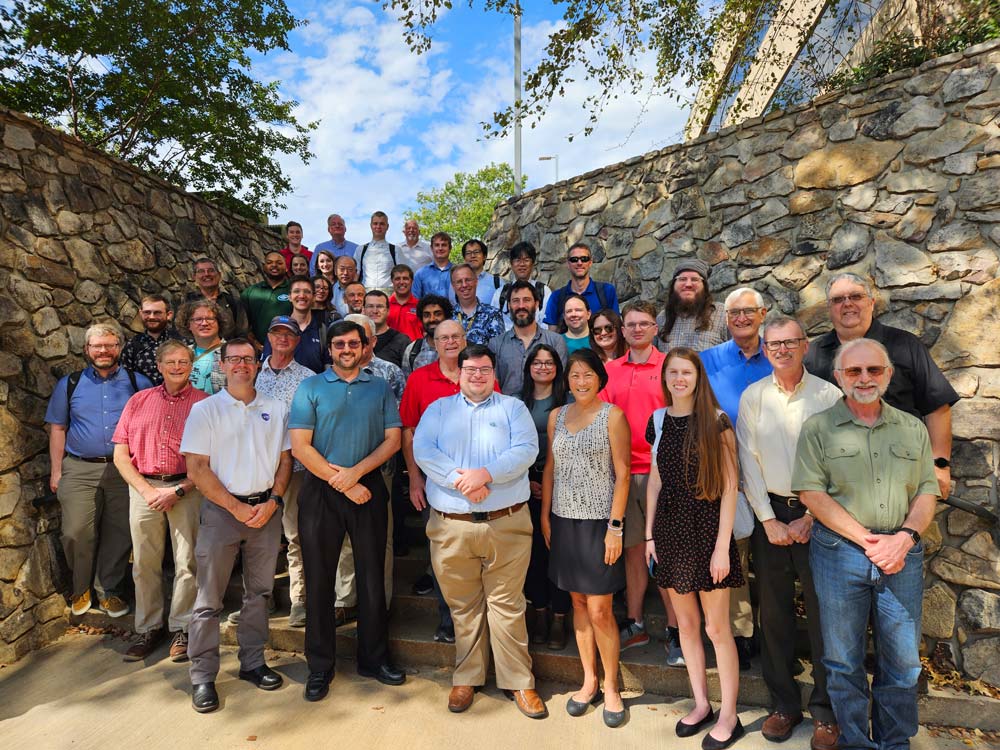
2024 Lightning Science Meeting attendees The GOES-R/GeoXO quarterly newsletter for April – September 2024 is now available. We successfully launched the final satellite in the GOES-R Series! Congratulations to the team for achieving this milestone! After reaching geostationary orbit on July 7, GOES-U was renamed GOES-19. Post-launch testing is underway, and I look forward to GOES-19 becoming GOES East next April. GOES-19 hosts a new space weather instrument, CCOR-1, on behalf of NOAA’s Space Weather Follow-On Program, which will observe the solar corona and provide critical data for space weather forecasting. There has also been a lot of progress on GeoXO. We selected vendors to build the spacecraft and the ACX, OCX and LMX instruments and are on track to complete the Mission Definition Review in late 2024.
October
-
September 24, 2024: NOAA Shares First Data from GOES-19 EXIS Instrument
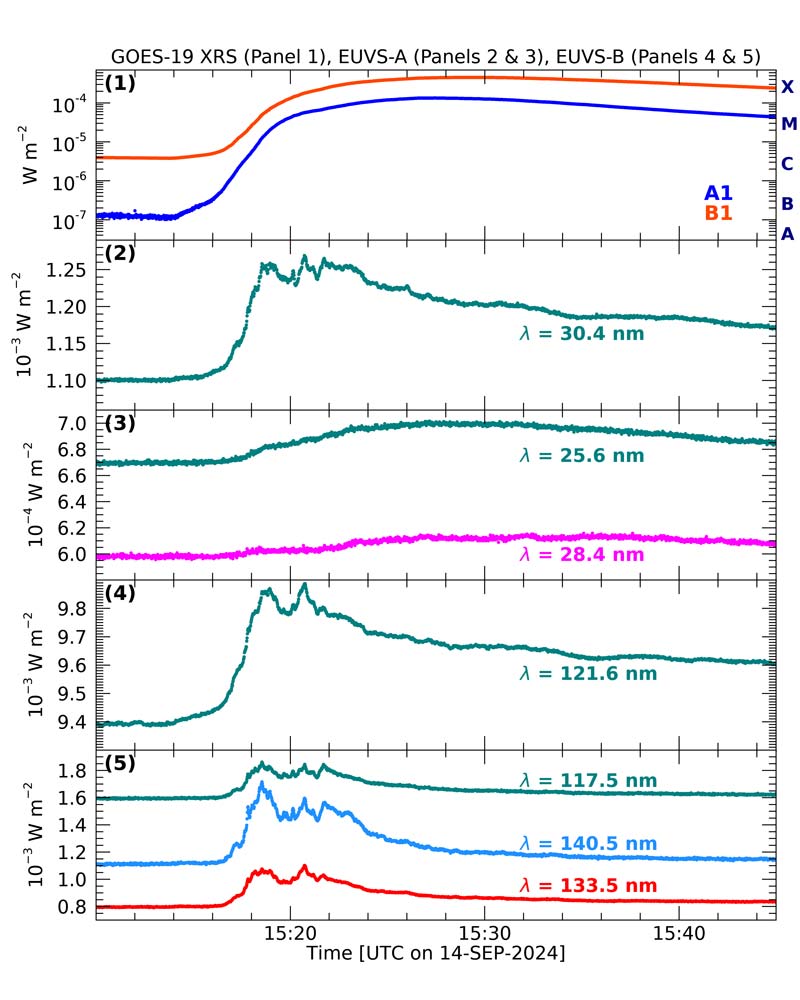
First data from the GOES-19 EXIS. Image credit: NOAA/NASA The Extreme Ultraviolet and X-ray Irradiance Sensors (EXIS) onboard NOAA’s GOES-19 satellite are powered on, performing well and observing the sun. On Sept. 14 2024, EXIS observed an X-class “extreme” solar flare that erupted from an active region of the sun that had just rotated into Earth’s view. Solar flares are huge eruptions of energy on the sun and often produce clouds of plasma traveling more than a million miles per hour. When these plasma clouds reach Earth, they can cause radio communications blackouts, disruptions to electric power grids, errors in GPS navigation, and hazards to satellites and astronauts. This particular flare resulted in aurorae visible as far south as Texas. EXIS, with its multiple sensors, can observe and quantify the light from solar flares and help determine in real-time whether a flare will affect us on Earth. EXIS data will provide NOAA’s Space Weather Prediction Center with early indications of impending space weather storms so forecasters can issue alerts, watches and warnings.
-
September 18, 2024: NOAA Debuts First Imagery from GOES-19
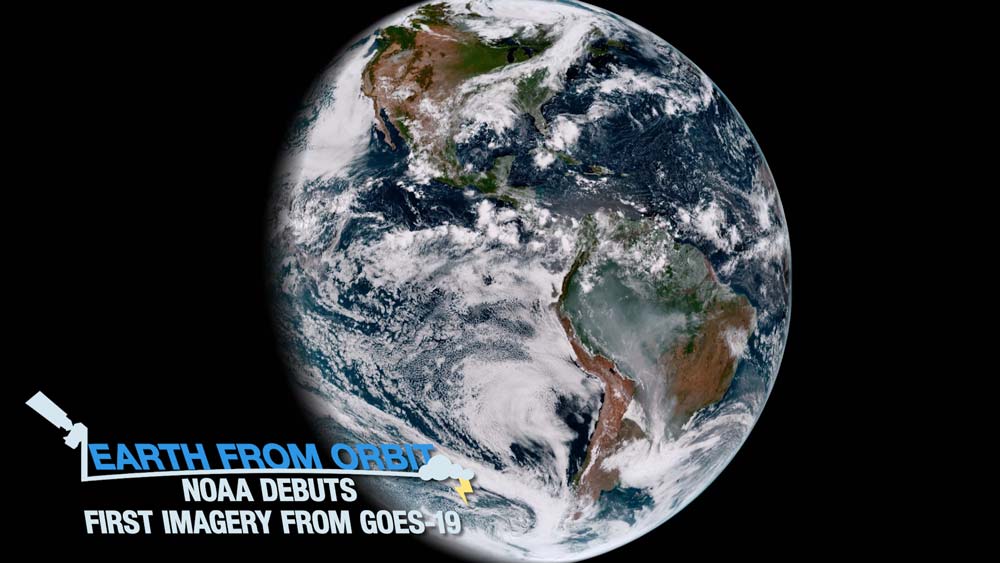
On Sept. 18, 2024, NOAA shared the first images of the Western Hemisphere from its GOES-19 satellite. The satellite’s Advanced Baseline Imager (ABI) instrument recently observed a number of weather events, environmental phenomena, and striking views of Earth. Wildfires in the Midwest and the Amazon blanketed nearby areas with smoke. Storms flared up over the Southeast and a low-pressure system over Canada brought severe weather. Tropical Storm Francine formed in the Gulf of Mexico and quickly developed into a hurricane, making landfall in Louisiana. GOES-19 also captured mesmerizing von Kármán vortices around Guadalupe island, cloud streets over Virginia, and cumulus clouds over the Midwest. GOES-19 is currently undergoing post-launch testing, which includes validation and calibration of its instruments, systems and data to prepare it for operations. NOAA plans for GOES-19 to replace GOES-16 as GOES-East in April 2025.
-
September 13, 2024: Earth from Orbit: Hurricane Francine Slams Northern Gulf Coast
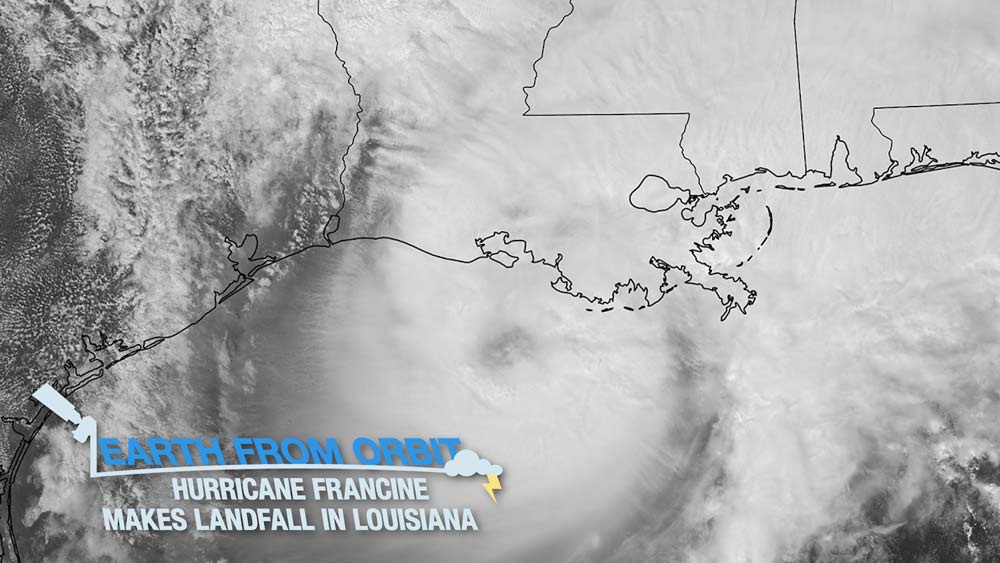
On Sept. 11, 2024, NOAA satellites monitored Hurricane Francine as it made landfall in Louisiana as a Category 2 hurricane. Francine developed into a tropical storm in the Gulf of Mexico on Sept. 9, as the historical peak of Atlantic hurricane season approached. The storm brought flash flooding and caused widespread power outages in Louisiana, Mississippi and Alabama. GOES-16 (GOES-East) watched in near real-time as Francine developed into a tropical storm and intensified into a hurricane. The satellite provided a detailed look of the storm and monitored cloud top cooling and lightning activity within the hurricane.
-
September 4, 2024: NOAA Shares First Data from GOES-19 SEISS Instrument

The Space Environment In-Situ Suite (SEISS) instrument onboard NOAA's GOES-19 satellite on June 25, 2024, is now sending radiation data back to Earth. Data collected from SEISS over the three-day time period from August 23–25, 2024, show a number of radiation belt disturbances. The radiation belts are regions of space around Earth filled with energetic electrons and protons that can damage or interfere with satellite electronics. The GOES-19 SEISS Magnetospheric Particle Sensor - High Energy observed several large dropouts followed by rapid increases in the radiation belt electron and proton fluxes during these disturbances. Following the rapid increases, MPS-HI observed periodic "drift echoes" (short duration flux enhancements), most clearly in the three lowest-energy proton channels (96 keV, 138 keV, and 193 keV traces), as these enhanced fluxes repeatedly drifted around the Earth and passed by the GOES-19 satellite. Once GOES-19 assumes its operational role as NOAA’s GOES-East satellite, the Space Weather Prediction Center will use GOES-19’s SEISS data to issue solar radiation storm and radiation belt alerts.
September
-
August 22, 2024: Earth from Orbit: Hurricane Ernesto
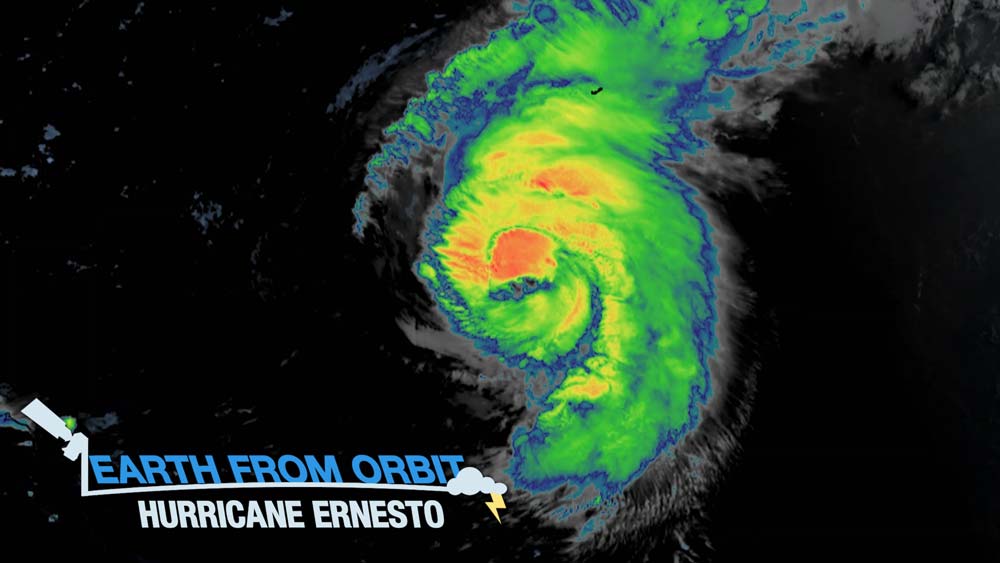
On Aug. 14, 2024, NOAA satellites watched Tropical Storm Ernesto intensify into a hurricane. The storm brought strong winds and flooding to the Virgin Islands and Puerto Rico before moving northward. As it traveled northward over the Atlantic Ocean toward Bermuda, Ernesto intensified into a Category 2 hurricane. On Aug. 17, Hurricane Ernesto made landfall in Bermuda as a Category 1 hurricane. Hurricane Ernesto also caused dangerous swells and rip currents along the U.S. East Coast. GOES-16 monitored the storm as it developed and intensified in near real-time, helping forecasters determine what areas would be impacted. Infrared imagery from GOES-16 indicated what areas of the hurricane were the most intense. The GOES-16 Geostationary Lightning Mapper also captured lightning activity within the storm.
-
August 15, 2024 : Earth From Orbit: A Look Back at Hurricane Debby
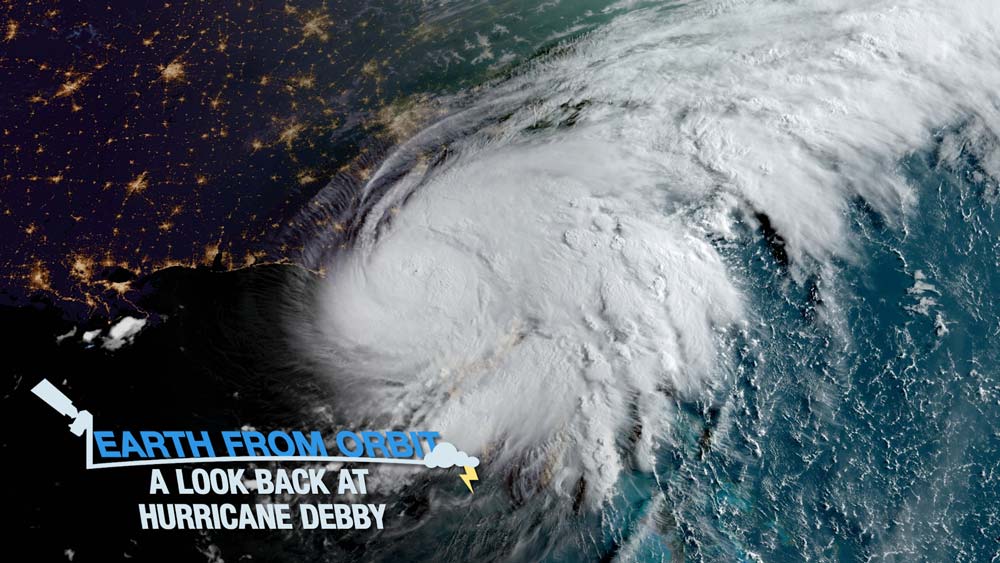
In early August 2024, NOAA satellites tracked Debby, a storm that impacted Florida’s Big Bend region near Steinhatchee before moving up the East Coast, causing widespread flooding and damaging winds as far north as New York state with numerous destructive tornadoes along its path. NOAA’s GOES-16 satellite monitored and tracked the storm in near real-time as it developed and moved northward. GOES-16 imagery revealed details such as cloud top cooling, winds and lightning activity, which help estimate a storm’s intensity.
-
August 13, 2024 : NOAA Shares First Data From GOES-19 Magnetometer
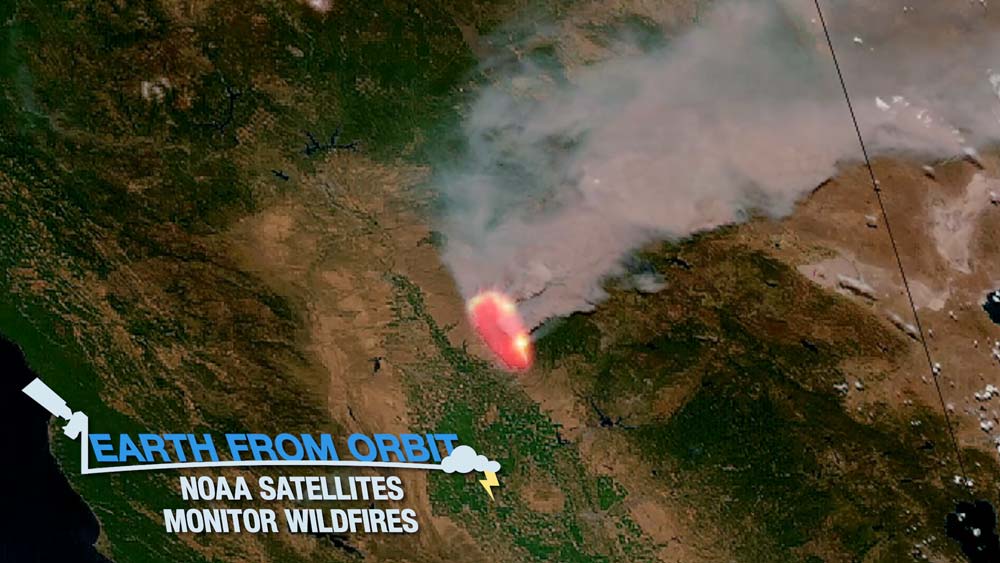
First data from the GOES-19 GMAG. The Goddard Magnetometer (GMAG) instrument, launched onboard NOAA’s GOES-19 satellite on June 25, 2024, is now transmitting magnetic field measurements down to Earth. On July 23, 2024, the GOES-19 GMAG captured a space weather phenomenon known as electromagnetic ion cyclotron waves. These waves play a significant role in controlling the levels of dangerous energetic particles that can cause damage to satellites and harm astronauts. GMAG space weather products can help to improve forecasts of the likelihood of elevated levels of dangerous energetic particles.
-
August 1, 2024 : Earth from Orbit: NOAA Satellite Monitor Wildfires

Roughly 100 wildfires are raging out of control across the western United States and hundreds more are burning in Canada, destroying homes, forcing evacuations, and affecting air quality. NOAA satellites have been closely monitoring these blazes, including California’s Park Fire, which is currently the largest active wildfire in the U.S. The Park Fire, which started on July 24, 2024, is believed to have been ignited by arson. A suspect has been arrested, accused of pushing a burning car into a gully, sparking the blaze. As of Aug. 1, the fire has consumed 392,480 acres across Butte, Plumas, Shasta, and Tehama counties. Fueled by very dry grass and brush, and driven by strong winds, the fire is only 18% contained.
August
-
July 19, 2024 : Earth from Orbit: Severe Thunderstorms Race Through the Midwest
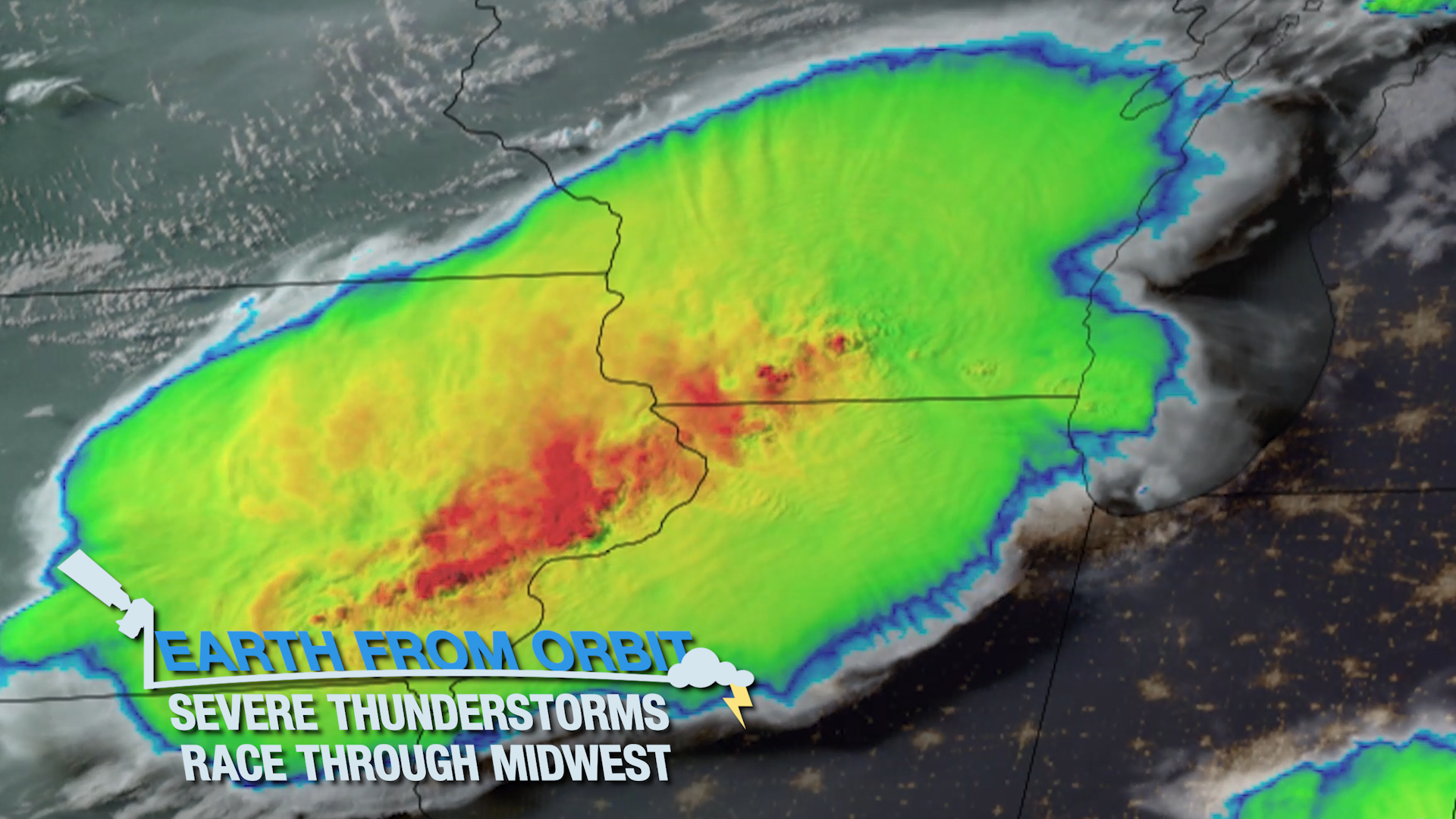
At the end of a humid day in the Midwest, GOES East watched as a derecho ripped through the region on July 15. The storm system developed and moved east across Iowa before reaching Illinois, Indiana and southwest Michigan. The Chicago National Weather Service office confirmed the derecho spawned at least 19 tornadoes in the Chicagoland area. GOES East saw the storms grow in size and intensity over Iowa. The Advanced Baseline Imager onboard GOES East captured infrared imagery revealing the structure of the storm and where it was the most intense. The Geostationary Lightning Mapper on GOES East also measured lightning within the storm system.
-
July 11, 2024 : Earth from Orbit: Hurricane Beryl Kicks Off 2024 Atlantic Hurricane Season
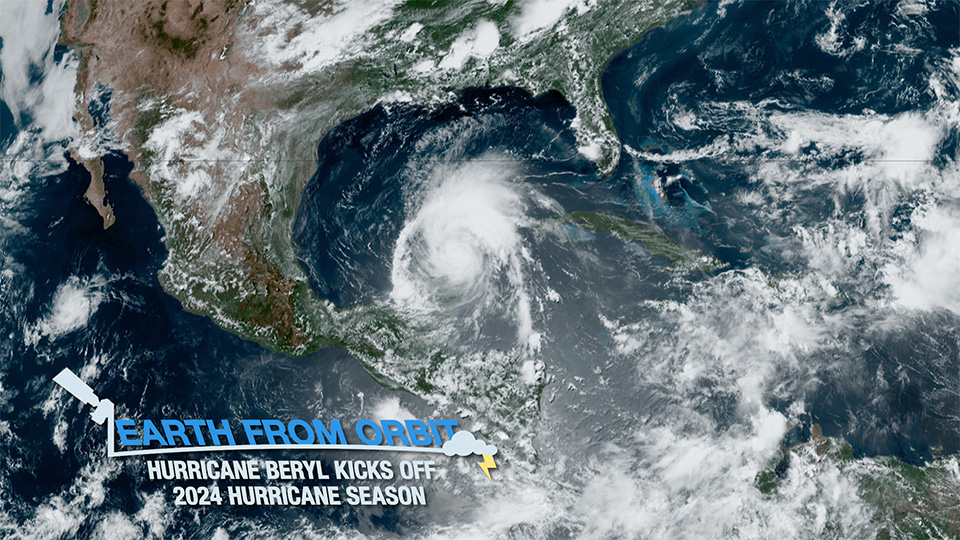
Hurricane Beryl Kicks Off 2024 Atlantic Hurricane Season. Photo credit: NOAA/NASA/CIRA Hurricane Beryl, the first hurricane of the 2024 Atlantic hurricane season, rapidly strengthened to a Category 5 storm unusually early in the year. This explosive strengthening was fueled in part by exceptionally warm ocean temperatures. Beryl first formed as a tropical depression on June 28, 2024, with winds of 35 mph; within the first 24 hours, the storm rapidly intensified into a hurricane with winds of 75 mph. This was the farthest east that a hurricane has formed in the month of June. In the following 24 hours, Beryl underwent another instance of rapid intensification becoming an extremely dangerous Category 4 hurricane. At that point Beryl became the first Category 4 hurricane to form in the month of June. On July 2, 2024, Beryl became the earliest Category 5 hurricane observed in the Atlantic on record and only the second Category 5 hurricane to occur in July.
-
July 7, 2024 : GOES-U Reaches Geostationary Orbit, Now Designated GOES-19
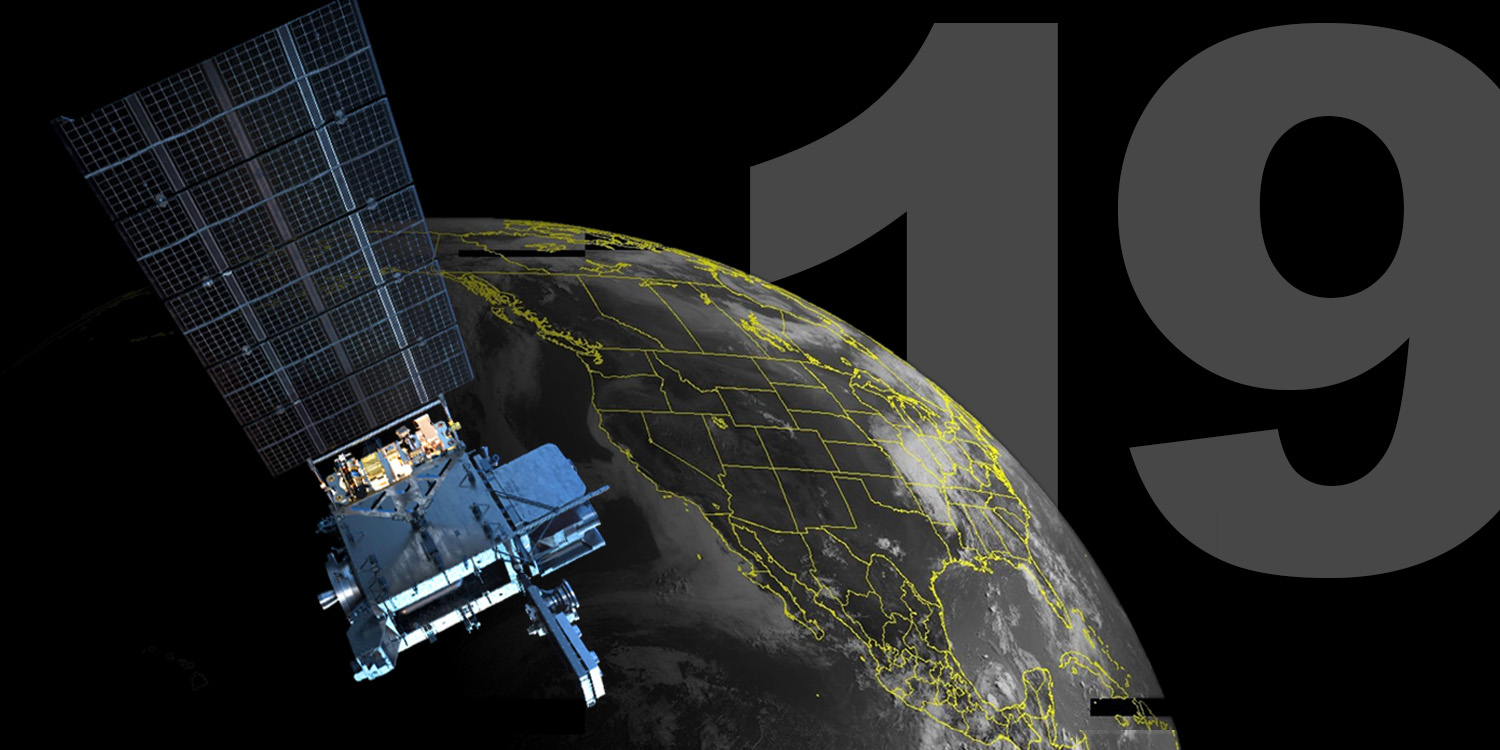
GOES-U Reaches Geostationary Orbit, Now Designated GOES-19 Photo credit: NOAA On July 7, 2024, GOES-U executed its final engine burn, placing the satellite in geostationary orbit 22,236 miles above Earth. Upon reaching this milestone, GOES-U was renamed GOES-19. GOES satellites are designated with a letter prior to launch and a number once they achieve geostationary orbit. NOAA’s GOES-U satellite launched on June 25, 2024, lifting off from NASA’s Kennedy Space Center in Florida. The satellite launched aboard a SpaceX Falcon Heavy rocket from Space Launch Complex 39A. The launch was managed by NASA’s Launch Services Program, based at Kennedy Space Center.
-
June 25, 2024: NOAA’s GOES-U Heads to Orbit for Historic Mission
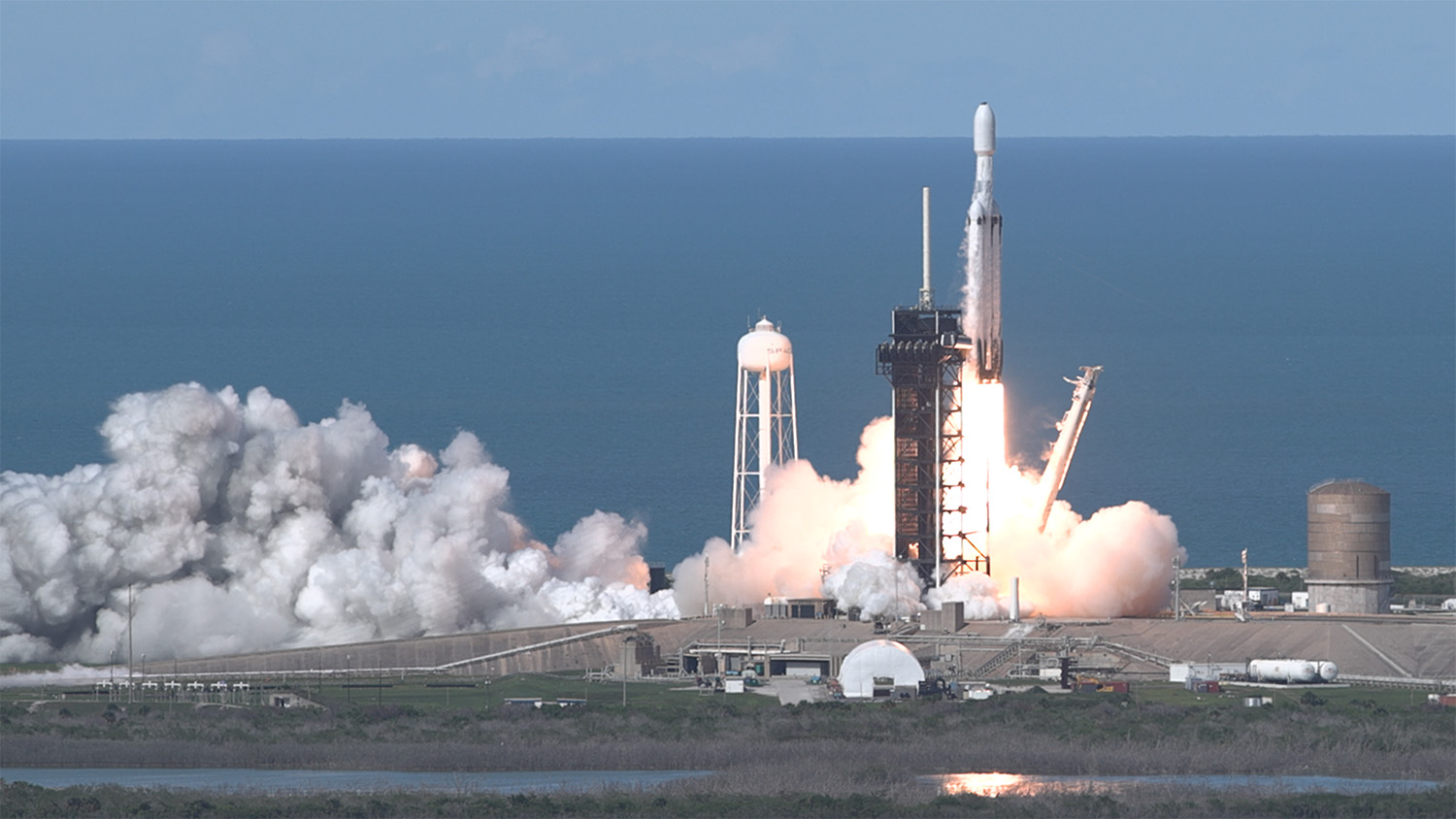
Liftoff of NOAA's GOES-U satellite from NASA’s Kennedy Space Center on June 25, 2024. Photo credit: NASA/Liz Wilk GOES-U, the latest of NOAA’s four advanced geostationary satellites, soared into orbit on a SpaceX Falcon Heavy rocket at 5:26 p.m. EDT from NASA’s Kennedy Space Center in Florida. At 10:18 p.m., mission managers confirmed the spacecraft’s solar arrays successfully deployed, and the spacecraft was operating on its own power. GOES-U will take about two weeks to reach its geostationary orbit. Once there, the satellite will be renamed GOES-19. On board GOES-U is a suite of seven instruments for collecting advanced imagery and atmospheric measurements, providing real-time mapping of lightning activity, and detecting approaching space weather hazards. Also on board for the first time is the compact coronagraph that will observe the sun’s outermost layer, called the corona, for large explosions of plasma that could produce geomagnetic solar storms.
-
June 20, 2024: NASA Completes Flight Readiness Review for GOES-U Mission
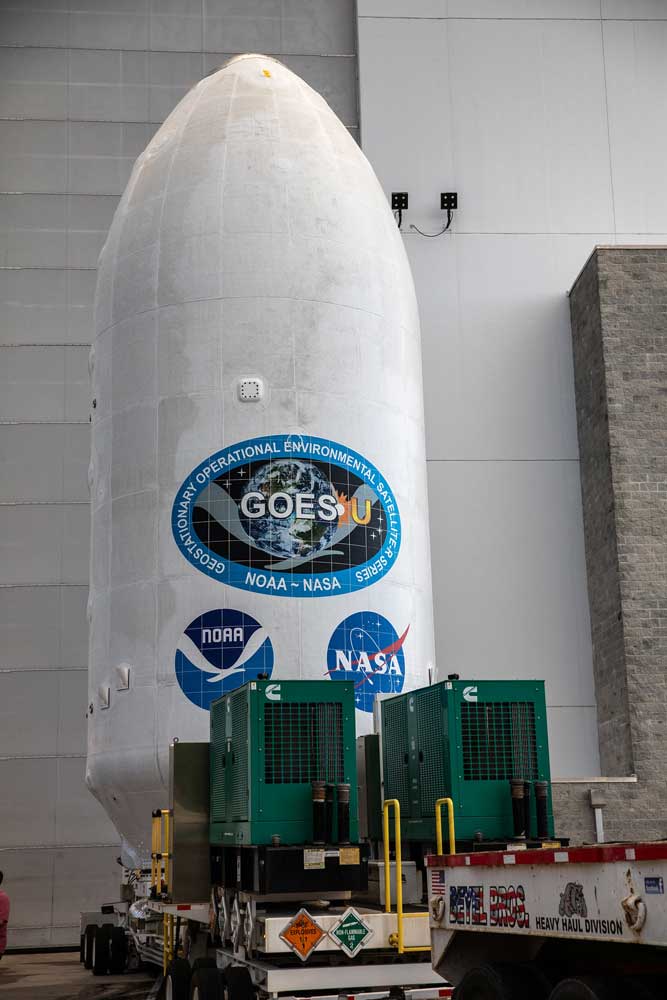
Crews transport NOAA’s GOES-U satellite from the Astrotech Space Operations facility to the SpaceX hangar at Launch Complex 39A at NASA’s Kennedy Space Center in Florida on Friday, June 14, 2024. Photo credit: NASA/Ben Smegelsky NASA, NOAA, SpaceX, and GOES-U mission managers met on June 20 to conduct a Flight Readiness Review at NASA’S Kennedy Space Center in Florida. During the review, teams provided an update on the mission status and certified the readiness to proceed with final launch preparation activities.
-
June 18, 2024: From GOES to GeoXO: Past Highlights to Future Horizons

For nearly 50 years, NOAA and NASA have partnered to develop NOAA’s geostationary satellites as part of the most sophisticated weather-observing, environmental monitoring, and space weather monitoring satellite system in the world. When NOAA’s GOES-U satellite is launched, it will be the fourth and final satellite in the GOES-R Series, and a bridge to a new age of advanced satellite technology – GeoXO. A new video, “From GOES to GeoXO: Past Highlights to Future Horizons,” offers a retrospective of the GOES legacy and a look to the future with GeoXO.
-
June 15, 2024: GOES-U Transported to Launch Complex 39A

Crews transport NOAA’s GOES-U from the Astrotech Space Operations facility to the SpaceX hangar at Launch Complex 39A at NASA’s Kennedy Space Center in Florida beginning on Friday, June 14, 2024, with the operation finishing early Saturday, June 15, 2024. Photo credit: NASA/Ben Smegelsky On June 15, 2024, GOES-U, encapsulated in its protective payload fairing, arrived at NASA Kennedy and SpaceX’s hangar at the spaceport’s Launch Complex 39A. Crews began transporting the satellite from the Astrotech Space Operations Facility in Titusville, Florida, on June 14, with the operation finishing early on June 15. The next mission milestone includes connecting the encapsulated GOES-U to the SpaceX Falcon Heavy rocket that will launch it into space, ahead of rolling the stack out to the launch pad.
-
June 13, 2024: GOES-U Encapsulated in Rocket Fairing

Technicians prepare NOAA’s GOES-U for encapsulation inside payload fairing halves on Thursday, June 13, 2024, at the Astrotech Space Operations facility in Titusville near NASA’s Kennedy Space Center in Florida. Photo credit: NASA/Ben Smegelsky On June 13, 2024, technicians encapsulated the 20-foot-tall GOES-U satellite inside two payload fairing halves in preparation for connecting it to the Falcon Heavy rocket that will launch the satellite into space. During the ascent phase of the launch, the fairing halves will protect GOES-U from aerodynamic pressure and heating. Once GOES-U no longer requires this protection, approximately four minutes after liftoff, the halves will be jettisoned and return to Earth, where SpaceX crews will recover them for use on future missions.
-
June 6, 2024: Prelaunch Media Viewing of NOAA's GOES-U Satellite
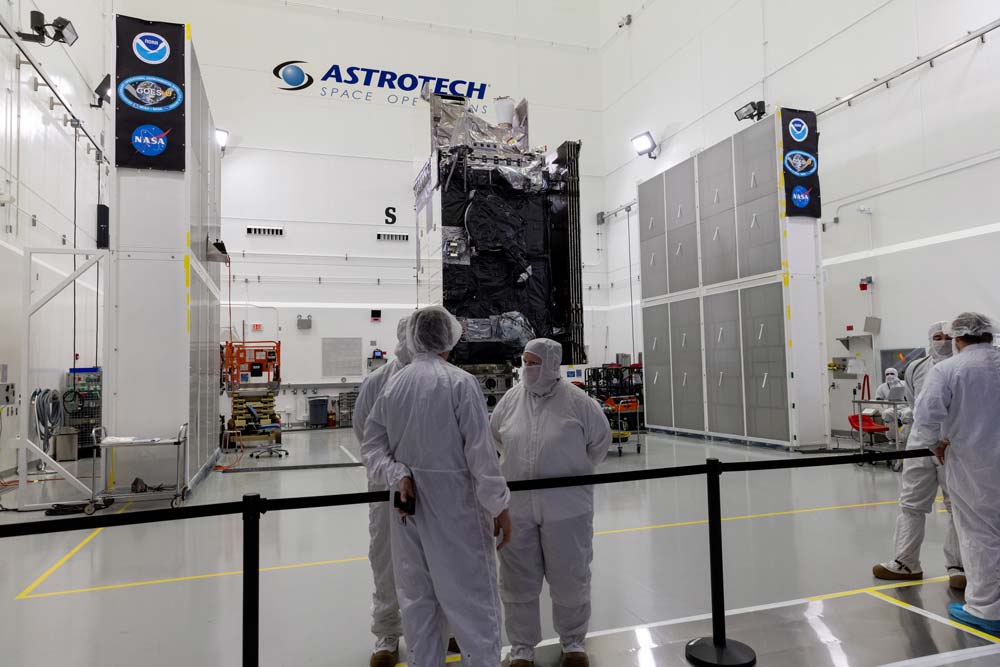
Members of the news media had an opportunity for an up-close look at NOAA's GOES-U satellite on June 6, 2024, inside the Astrotech Space Operations Facility in Titusville, near NASA’s Kennedy Space Center in Florida. Photo credit: NASA/Kim Shiflett On June 6, 2024, NASA and NOAA hosted a media availability to view and photograph the GOES-U satellite at the Astrotech Space Operations payload processing facility in Titusville, Florida. Subject matter experts from NASA, NOAA, Lockheed Martin, and L3Harris Technologies provided a mission overview and answered questions about the satellite’s capabilities to assist meteorologists with predicting, observing, and tracking hazardous weather events on Earth and in space. The opportunity provided media with a last look at the final weather-observing and environmental monitoring satellite in NOAA’s GOES-R Series before technicians prepare it for launch aboard a SpaceX Falcon Heavy rocket. View photos and video of media day.
-
June 4, 2024: GOES-U Art Challenge Selections Announced

Last month, we challenged kids to draw how they imagine lightning looks either within the clouds or striking the ground, from above the sky or from their window. The GOES-U satellite will help scientists “see” lightning and predict where it will strike, helping meteorologists forecast the path of hurricanes, how strong severe thunderstorms can become, and when tornadoes will form. Thank you to everyone who participated! We chose 23 selections to feature.
July
June
-
May 21, 2024: Earth from Orbit: Ocean Color Observations
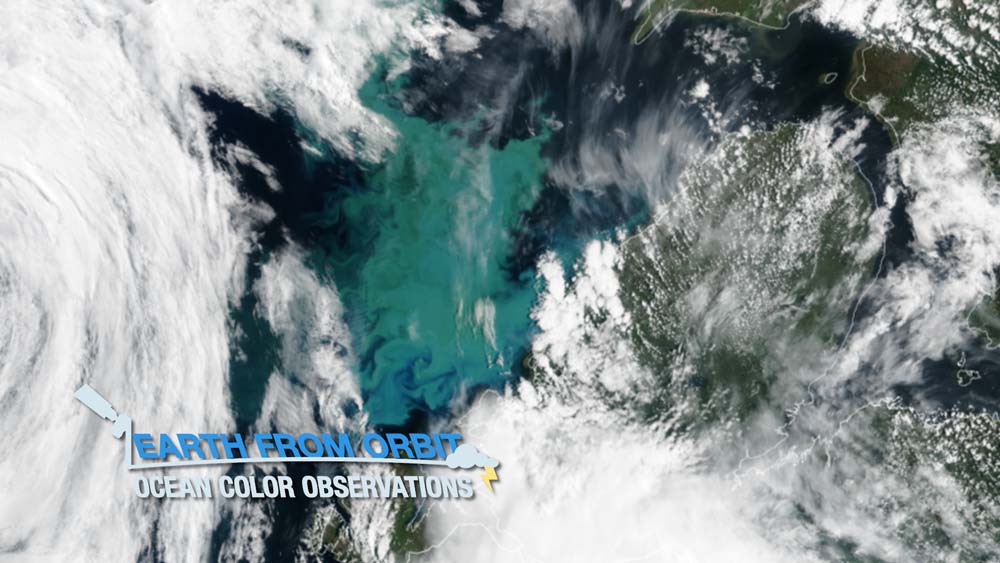
Earth-observing satellites can see many different things, from changing seasons, weather patterns, and land features. From their unique view, satellites can also observe the deep swirling hues and colors of the ocean. With data from NASA’s PACE mission now available, NOAA and NASA are collaborating to develop applications for monitoring various indicators of ecosystem health. NOAA is also preparing for a more advanced Ocean Color instrument (OCX) to be flown on the future GeoXO mission. Having an ocean color instrument on a geostationary satellite such as GeoXO will allow continuous monitoring of a specific area. Additionally, its higher resolution imagery will improve observations of water clarity, chlorophyll concentrations, and help distinguish different types of phytoplankton. GeoXO will begin operating in the early 2030s, taking over after the GOES-R series reaches the end of its operational lifetime.
-
May 1, 2024: GOES-U Art Challenge
Have you ever watched a lightning storm from your window at home? Did you know that scientists can use weather satellites to watch lightning from above, too? On June 25, 2024, NOAA will be launching its latest weather satellite called GOES-U (GOES is short for Geostationary Operational Environmental Satellite). GOES-U will be the fourth and final satellite in the GOES-R group of satellites that keep an eye on Earth’s weather from space. GOES-U will also help scientists “see” lightning and predict where it will strike.
Challenge: Draw how you imagine lightning to look, either within the clouds or striking the ground, from above the sky or from your window. Use any materials you would like – crayons, markers, pencils, pens, aluminum foil, paint, yarn, or anything else you find. The sky's the limit!
The art challenge is open through May 31, 2024. Selected art submissions will appear online and in social media the first week of June. Visit our art challenge webpage for instructions for submitting your art.
May
-
April 19, 2024: Earth from Orbit: Celebrating Earth Day with NOAA Satellites
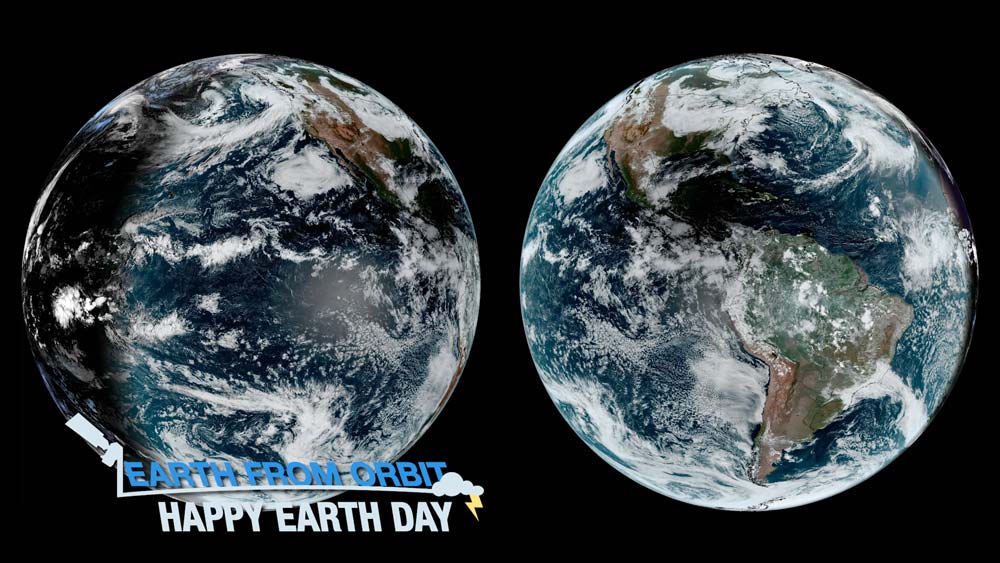
Throughout history, humans have wondered what Earth looked like from above. The advent of satellites changed our perspective dramatically, though early imagery was often blurry and lacked detail. Today, thanks to decades of technological advancements and innovation, the quality and resolution of satellite imagery has significantly improved. Satellites from NOAA and other organizations around the world capture vital information that help us stay safe, while also sharing the beauty of our planet from afar. For us, every day is Earth Day!
-
April 12, 2024: Earth from Orbit: NOAA Satellites View Total Solar Eclipse
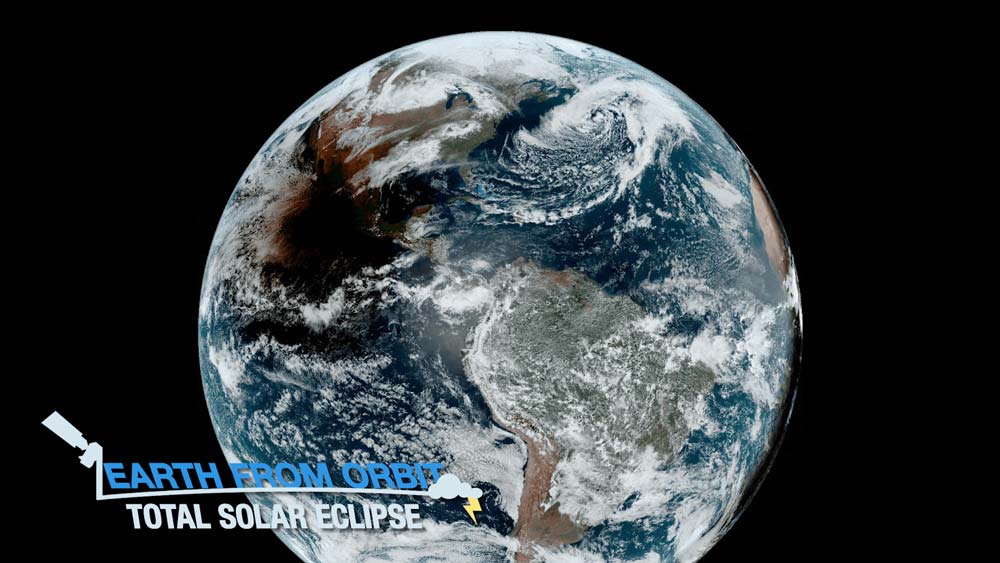
On April 8, 2024, the moon moved directly between the Earth and sun, completely blocking the sun’s light and causing a total solar eclipse. During this event, the moon’s shadow passed over parts of Mexico, the United States, and Canada, and millions of people were treated to a celestial show where the sky darkened as if it were dawn or dusk throughout its path of totality. NOAA satellites play a crucial role in observing solar eclipses and their effects. GOES-16 and GOES-18 watched the moon’s shadow pass over the Earth. The satellites also captured the effects of the eclipse shadow on surface weather, including the drop in land and air surface temperature, and dissipation of clouds. Although solar eclipses happen all over the Earth about twice a year, the next total solar eclipse is not predicted to occur in the United States until March 30, 2033, where it will be seen from northwestern Alaska. Another will occur across parts of Canada, Montana, and the Dakotas on Aug. 23, 2044. However, it won’t be until Aug. 12, 2045, when one will cross the contiguous United States from California to Florida.
-
April 11, 2024: First Quarter 2024 GOES-R/GeoXO Newsletter
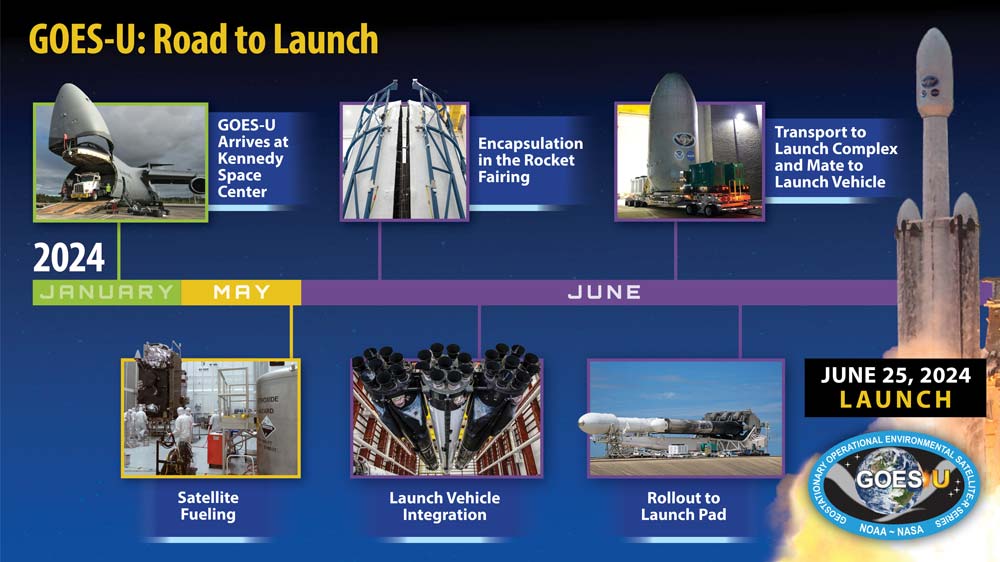
The GOES-R/GeoXO quarterly newsletter for January – March 2024 is now available. Excitement is building for the GOES-U launch, now scheduled for June 25, 2024. SpaceX has repaired the liquid oxygen leak found during testing of the center core booster and launch preparations are back on track. The team is preparing for satellite fueling and encapsulation in the rocket fairing, conducting mission tests and rehearsals, and preparing for the remaining pre-launch reviews. Meanwhile, we are also working hard on GeoXO. The team conducted a successful kickoff meeting for the Sounder and work continues on the Imager. Evaluation boards are busy reviewing proposals for the spacecraft and the OCX, LMX, and ACX instruments. We plan to award the remaining GeoXO contracts by fall.
April
-
March 26, 2024: Earth from Orbit: NOAA Satellites Detect Severe Solar Storm
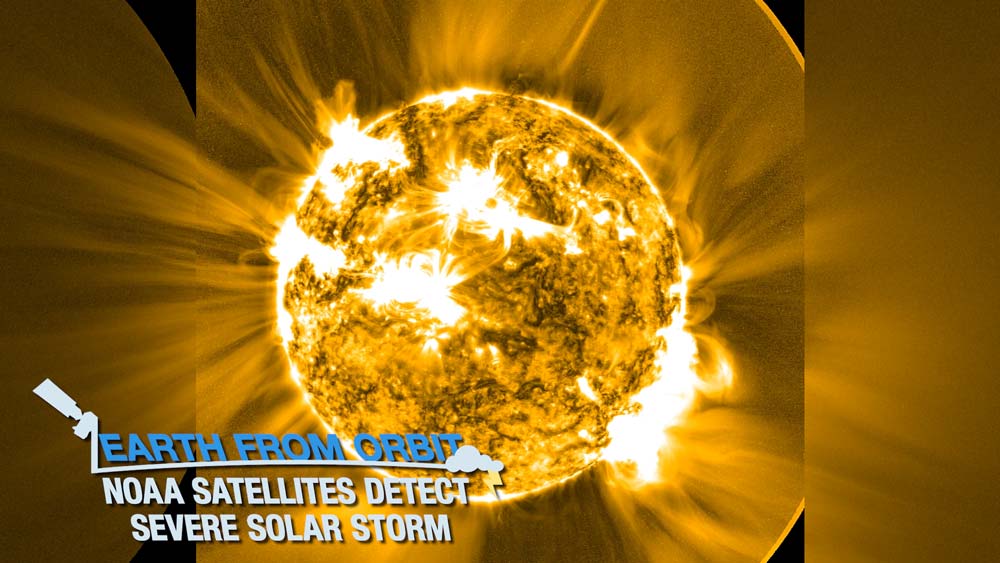
On March 23–24, 2024, NOAA’s GOES-16 and GOES-18 satellites, and others operated by international partners, observed numerous flares erupt from the sun, including a powerful X-class solar flare. Additionally, a surge of extremely hot plasma, known as a coronal mass ejection (CME), raced toward Earth, resulting in geomagnetic storms and auroras. The EXIS instruments onboard both GOES-16 and GOES-18 detected the flare. The satellites’ SUVI instruments viewed the flare and the initiation of the CME. Solar activity is expected to increase as Solar Cycle 25 reaches its peak, which is expected this year. NOAA and partner satellites will continue to watch for increased solar activity.
-
March 26, 2024: GOES-U Mission Overview Video
NOAA is preparing for a milestone satellite launch in 2024. GOES-U will be the fourth and final satellite in NOAA’s latest generation of geostationary operational environmental satellites called the GOES-R Series—the nation’s most advanced weather-observing and environmental monitoring satellite system. Like the three other GOES-R Series satellites already in orbit, GOES-U will provide near real-time, high-resolution imagery that will deliver critical information for weather forecasts, severe weather prediction, lightning detection, and space weather forecasts. GOES U will also carry something new when it launches – a critical space weather instrument called the Compact Coronagraph-1, or CCOR-1. Being able to monitor the sun’s corona helps scientists detect and characterize coronal mass ejections that can spark geomagnetic storms here on Earth– the costliest type of space weather events that can cause widespread damage to power grids, satellites, and communication and navigation systems.
-
March 26, 2024: NASA, SpaceX Target New Launch Date for NOAA Weather Satellite
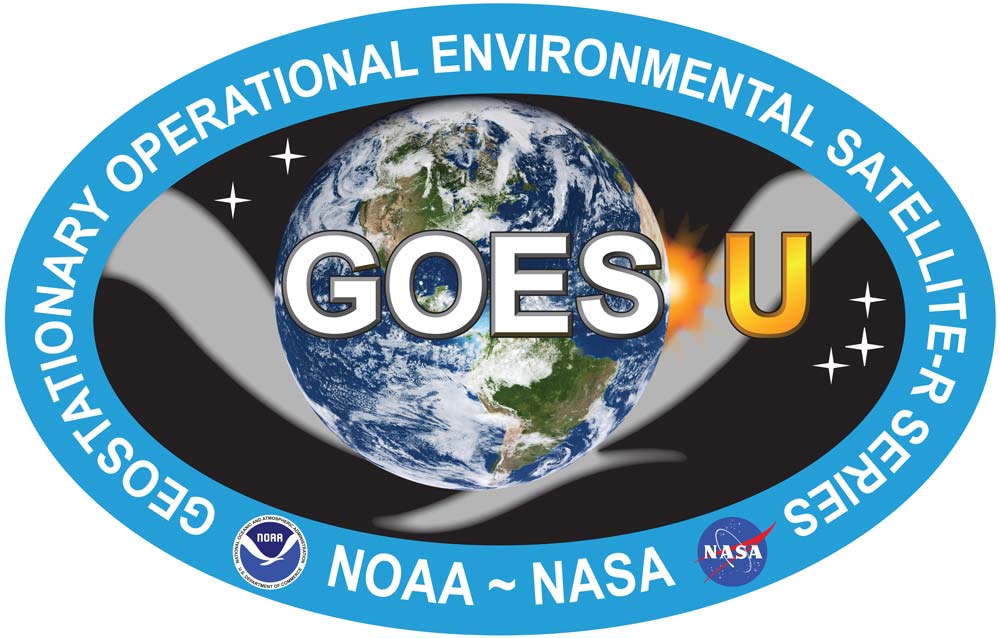
NASA and SpaceX now are targeting Tuesday, June 25, for the launch of GOES-U, the fourth and final satellite in National Oceanic and Atmospheric Administration’s (NOAA) Geostationary Operational Environmental Satellites (GOES) – R Series. The new launch date allowed time for teams to fully repair and test the Falcon Heavy core booster after a liquid oxygen leak was identified during routine new booster testing in February. NASA and SpaceX teams have resumed preparation of the GOES-U launch. GOES-U will launch on a SpaceX Falcon Heavy rocket from Launch Complex 39A at the agency’s Kennedy Space Center in Florida.
-
March 7, 2024: Earth from Orbit: Fires Rage Across Texas Panhandle
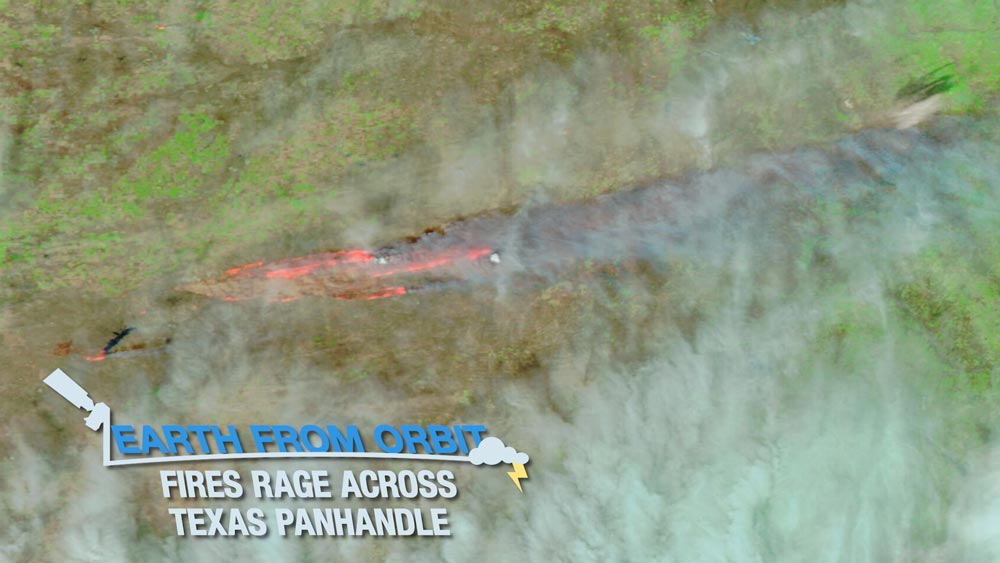
Since late February, NOAA satellites have been tracking wildfires that spread through the Texas Panhandle. The largest wildfire in the state’s history broke out on Feb. 26 and quickly spread, fueled by dry, windy conditions. By Mar. 4, the blaze, known as the Smokehouse Creek fire, had become one of the largest fires in U.S. history. GOES-16 (GOES East) observed these fires in near-real time. This geostationary satellite keeps constant watch over the same geographic area over time, and helps to locate fires, detect changes in a fire’s behavior, and predict its direction. By combining data from multiple channels on its Advanced Baseline Imager (ABI) instrument, both a fire’s hot spot and associated smoke plume can be visualized.
-
March 1, 2024: Earth from Orbit: Great Lakes Ice Reaches Historic Low
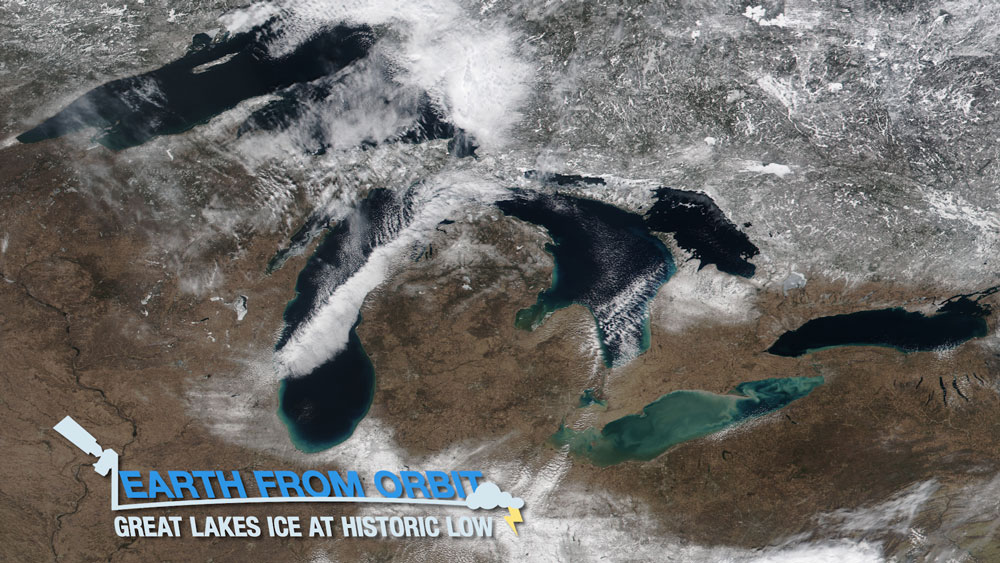
As we leave meteorological winter behind, NOAA satellites have been monitoring the extent of ice coverage in the Great Lakes. The Great Lakes typically see peak ice coverage in late February to early March. Ice plays an important role in the ecosystems, economy, and coastal resilience of the Great Lakes. In 2024, ice coverage reached a historic low. A number of factors have contributed to the historic low this year, such as a strong El Niño and well above-average temperatures this winter. NOAA satellites have observed little ice on the Great Lakes this year.
March
-
February 27, 2024: Launch of GOES-U Satellite Delayed
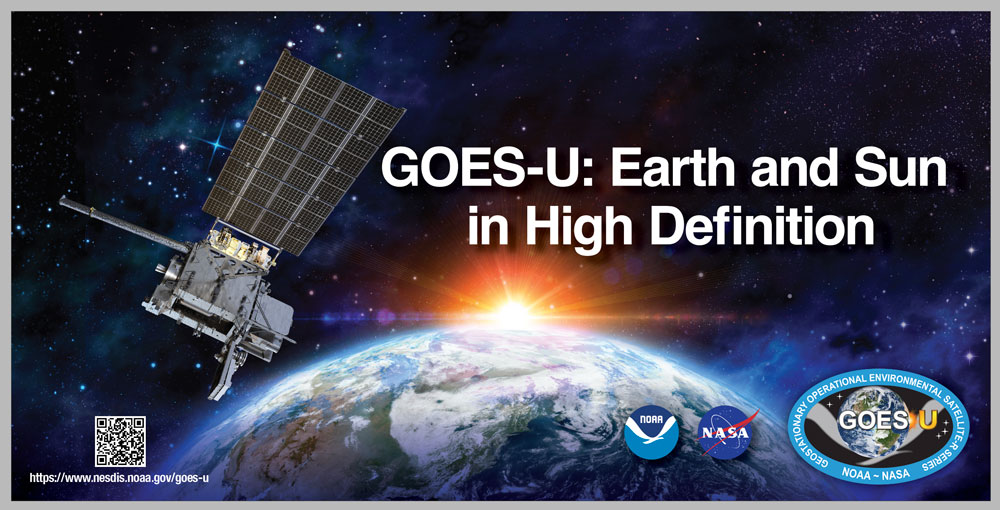
NASA and SpaceX are now targeting no earlier than May 2024 for the launch of NOAA's GOES-U satellite. The new date allows for additional testing and preparation of a new Falcon Heavy center core booster after a liquid oxygen leak was discovered during routine new booster testing. GOES-U is the fourth and final satellite in the GOES-R Series of advanced geostationary satellites.
-
February 8, 2024: Earth from Orbit: GOES-U Arrives at Kennedy Space Center
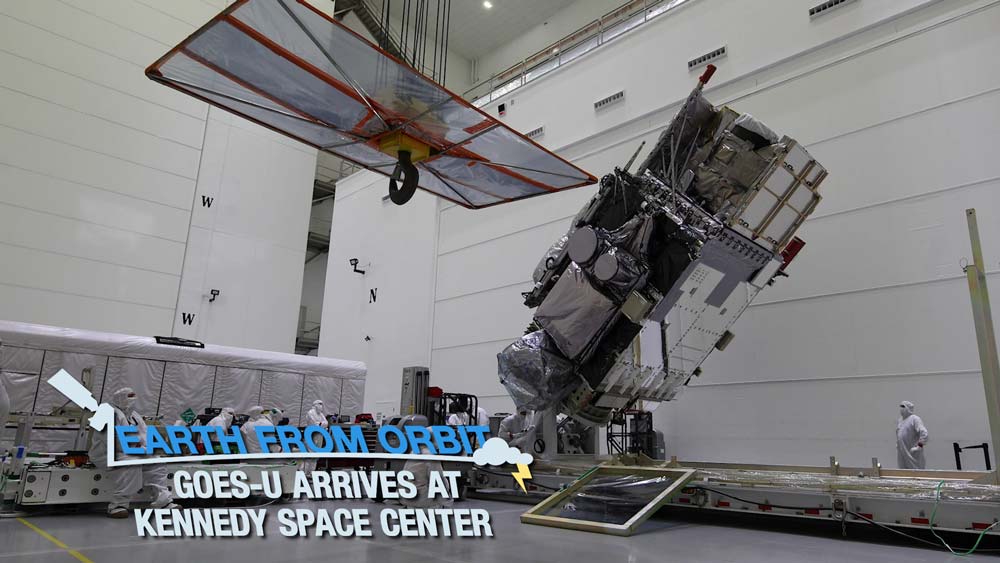
The latest video in the Earth from Orbit series highlights GOES-U’s arrival at Kennedy Space Center last month. After being packed in a high-tech shipping container that acts as a mobile clean room, GOES-U caught a ride aboard a C-5 Super Galaxy aircraft from Buckley Space Force Base in Colorado to NASA’s Kennedy Space Center in Florida. After landing, the satellite was taken to Astrotech Space Operations, where it was removed from its shipping container, inspected, and placed onto a test stand. GOES-U will now undergo final preparations for a spring 2024 launch from Kennedy Space Center, where it will launch aboard a SpaceX Falcon Heavy rocket.
February
-
January 23, 2024: GOES-U Arrives at Kennedy Space Center
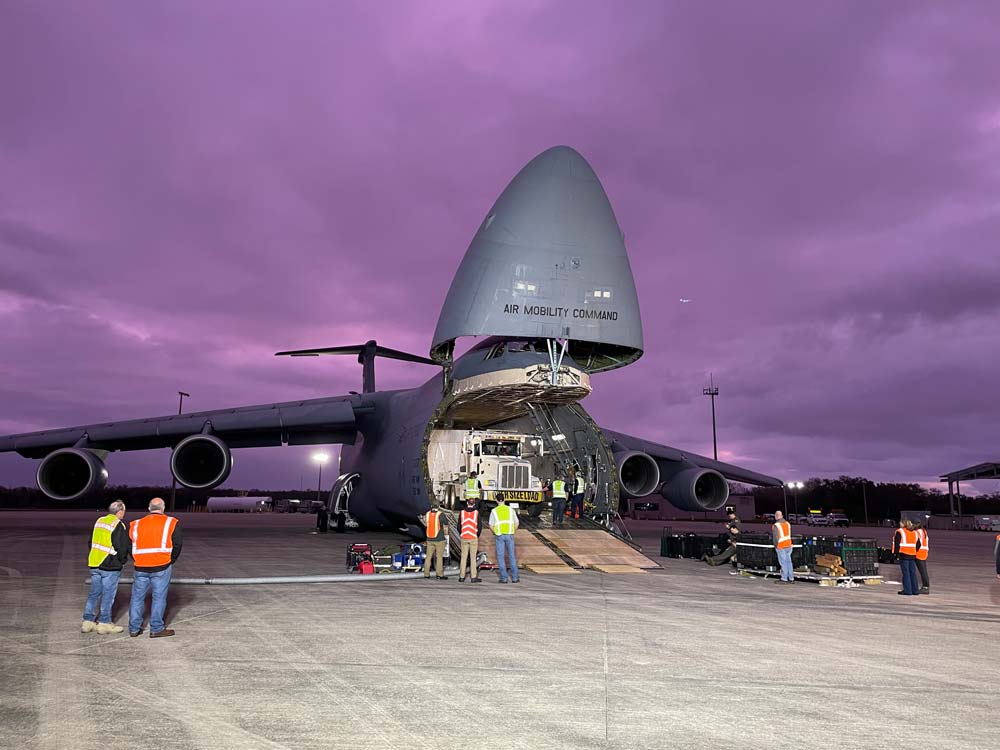
The satellite is in Florida to begin final preparations for its upcoming launch. NOAA’s GOES-U, the fourth and final satellite in the GOES-R Series of advanced weather-observing and environmental monitoring satellites, arrived at NASA’s Kennedy Space Center in Florida on Jan. 23, 2024, to begin final preparations for its upcoming launch. Shipping a satellite is no small feat. GOES-U is the size of a small school bus and weighs over 6,000 pounds! The spacecraft team at Lockheed Martin in Littleton, Colorado, where GOES-U was built, packed the satellite in a high-tech shipping container that protected its sensitive instruments and acted as a mobile clean room during transport. GOES-U was then driven to Buckley Space Force Base in Aurora, Colorado, and loaded on the C-5M Super Galaxy cargo transport that carried it to Florida. GOES-U safely landed at the NASA Launch and Landing Facility airstrip at Kennedy Space Center and was transported to the Astrotech Space Operations spacecraft processing facility in nearby Titusville, where it will go through a series of electrical tests to confirm it is working properly and mechanical configurations to prepare it for launch. GOES-U is scheduled to launch no earlier than April 30, 2024.
-
January 17, 2024: GOES-U: Road to Launch
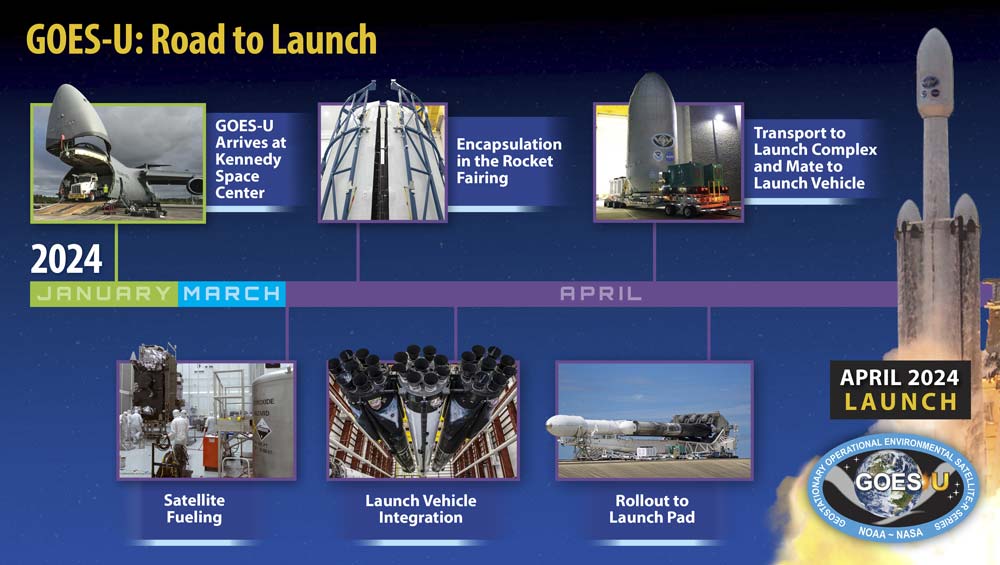
NOAA’s GOES-U, the fourth and final satellite in the Geostationary Operational Environmental Satellites (GOES) – R Series, the Western Hemisphere’s most advanced weather-observing and environmental monitoring system, is entering the final stage of preparations before liftoff. NASA and SpaceX are targeting no earlier than April 30 for the launch of GOES-U on a Falcon Heavy rocket. The GOES-U team has spent years building the instruments and spacecraft, integrating all the satellite’s components, and conducting rigorous testing to ensure it can withstand the harsh launch conditions and successfully take up residence 22,236 miles above Earth. Before that happens, the spacecraft must complete several final milestones. Learn more about GOES-U’s road to launch.
-
January 11, 2024: Fourth Quarter 2023 GOES-R/GeoXO Newsletter

The GOES-R Program and L3Harris celebrated the GOES-R ground system development contract close-out The GOES-R/GeoXO quarterly newsletter for October – December 2023 is now available. Happy New Year! It’s a very exciting time for the GEO Program! We are gearing up to launch the last of the GOES-R Series satellites. GOES-U will soon ship to Kennedy Space Center and begin final preparations for its planned launch in April. GeoXO also had a successful quarter. The final development RFP, for the ACX instrument, was released in October. Evaluation boards are busy reviewing proposals for the spacecraft and the OCX, LMX, and ACX instruments. GOES-16 and GOES-18 continue to provide critical data to keep us informed of and safe from severe weather and environmental hazards. The program is looking forward to more GEO successes in 2024!
-
January 4, 2024: Earth from Orbit: 2023 Satellite Imagery: A Year in Review
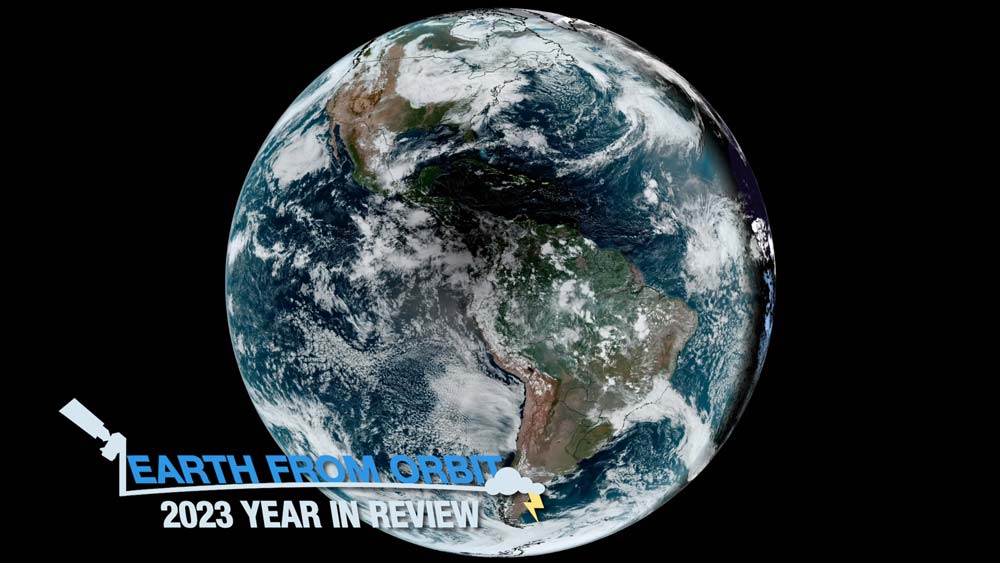
NOAA satellites see our planet from a unique and captivating perspective. Every year, they capture the beauty and wrath of Mother Nature unfolding beneath them—devastating hurricanes, raging wildfires, erupting volcanoes—as well as the changing seasons, ocean color, nighttime lights, and more. The view of NOAA satellites isn’t just limited to Earth; they also capture images of our moon and the sun as we navigate our cosmic journey. As we head into the new year, take a look back at some satellite imagery highlights from 2023.
